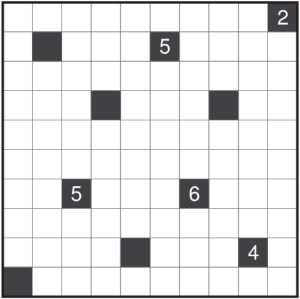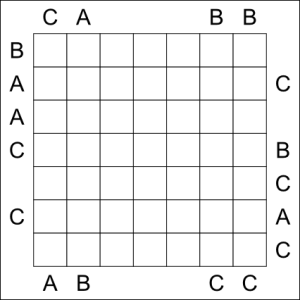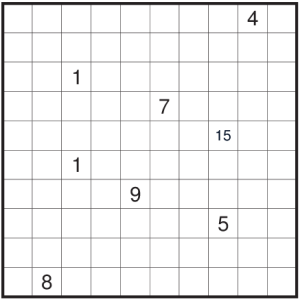I’m not numbering these simply because I don’t want to rush to 200 as I’m not ready with an idea for that 😛
These are puzzles that can be used for practice for the Indian Puzzle Championship and you can refer to the Instruction booklet provided on that link for better understanding of the rules with examples.. These are mostly around the difficulty I’ve generally seen at IPC, i.e. , around easy for experienced solvers, somewhere from medium to more for the first time solvers.
I’ve concentrated on types that are not on my blog already. You can see previous posts for Masyu, Slitherlink, Tapa, Graffiti Snake here and here. I wasted a lot of today making a Liar Slitherlink only to find that I’d made a stupid error right at the start. Thats why only 6 puzzles, I hope to have either a Liar Slitherlink, or some other puzzles ready tomorrow, and Friday. Lets hope I get them working 😉
Anyway, obviously the heading suggests what I’m gonna open with.
As Easy As IPC
Enter the letters I, P and C, so that each letter appears exactly once in every row and column. Some cells will remain empty in each row and column. The letters outside the grid show the first seen letter from that direction.

Tapa Borders
Paint some empty cells to create a continuous wall. Numbers in a cell indicate the length of painted blocks on its neighboring cells. If a cell has more than one number, there must be at least one white cell between the blocks. No 2×2 squares can contain only painted cells. The borders between some cells may be thick or non existent. A thick border separating two cells means one is painted and one is not. Lack of a border means the 2 cells are either both painted or both white.

Battleships
Locate the indicated fleet in the grid. Each segment of a ship occupies a single cell. Ships can be rotated but cannot be reflected. Ships do not touch each other, even diagonally. Some ship segments, or sea cells without ship segments, are given in the grid. The numbers outside the grid reveal the total number of ship segments in that row or column.
Note : The letters A, B, C may be equal or unequal, the only constraint I’ve added is that their sum equals 4. This is just to introduce first timers to the summing up logic that can be used sometimes in this type.

Snake
Locate a snake in the grid, whose head and tail are given. The snake does not touch itself even at a point. Numbers outside the grid indicate lengths of snake segments in the corresponding direction.

Star Battle
Place the given number of stars in each row, each column and each region. Stars cannot touch each other, not even diagonally.

Colored Star Battle
I’m new to this type myself even as a solver, so the puzzle may leave a lot to be desired. Sorry about that. Although it should be an easy warm up for first timers, I do think the difficulty of the IPC one will be higher given the high points. Anyway, Place the given number of stars in each row, each column and each region. Similarly colored stars cannot touch each other, not even diagonally. Some stars may be given.






















